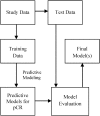Machine learning for predicting the response of breast cancer to neoadjuvant chemotherapy
- PMID: 23616206
- PMCID: PMC3721158
- DOI: 10.1136/amiajnl-2012-001332
Machine learning for predicting the response of breast cancer to neoadjuvant chemotherapy
Abstract
Objective: To employ machine learning methods to predict the eventual therapeutic response of breast cancer patients after a single cycle of neoadjuvant chemotherapy (NAC).
Materials and methods: Quantitative dynamic contrast-enhanced MRI and diffusion-weighted MRI data were acquired on 28 patients before and after one cycle of NAC. A total of 118 semiquantitative and quantitative parameters were derived from these data and combined with 11 clinical variables. We used Bayesian logistic regression in combination with feature selection using a machine learning framework for predictive model building.
Results: The best predictive models using feature selection obtained an area under the curve of 0.86 and an accuracy of 0.86, with a sensitivity of 0.88 and a specificity of 0.82.
Discussion: With the numerous options for NAC available, development of a method to predict response early in the course of therapy is needed. Unfortunately, by the time most patients are found not to be responding, their disease may no longer be surgically resectable, and this situation could be avoided by the development of techniques to assess response earlier in the treatment regimen. The method outlined here is one possible solution to this important clinical problem.
Conclusions: Predictive modeling approaches based on machine learning using readily available clinical and quantitative MRI data show promise in distinguishing breast cancer responders from non-responders after the first cycle of NAC.
Keywords: DCE-MRI; breast cancer; diffusion MRI; machine learning; neoadjuvant chemotherapy; predictive modeling.
Figures


Similar articles
-
Impact of Machine Learning With Multiparametric Magnetic Resonance Imaging of the Breast for Early Prediction of Response to Neoadjuvant Chemotherapy and Survival Outcomes in Breast Cancer Patients.Invest Radiol. 2019 Feb;54(2):110-117. doi: 10.1097/RLI.0000000000000518. Invest Radiol. 2019. PMID: 30358693 Free PMC article.
-
Early assessment of breast cancer response to neoadjuvant chemotherapy by semi-quantitative analysis of high-temporal resolution DCE-MRI: preliminary results.Magn Reson Imaging. 2013 Nov;31(9):1457-64. doi: 10.1016/j.mri.2013.07.002. Epub 2013 Aug 15. Magn Reson Imaging. 2013. PMID: 23954320 Free PMC article. Clinical Trial.
-
Early prediction of the response of breast tumors to neoadjuvant chemotherapy using quantitative MRI and machine learning.AMIA Annu Symp Proc. 2011;2011:868-77. Epub 2011 Oct 22. AMIA Annu Symp Proc. 2011. PMID: 22195145 Free PMC article.
-
Meta-Analysis of Quantitative Dynamic Contrast-Enhanced MRI for the Assessment of Neoadjuvant Chemotherapy in Breast Cancer.Am Surg. 2019 Jun 1;85(6):645-653. Am Surg. 2019. PMID: 31267907 Review.
-
Machine learning with multiparametric magnetic resonance imaging of the breast for early prediction of response to neoadjuvant chemotherapy.Breast. 2020 Feb;49:115-122. doi: 10.1016/j.breast.2019.11.009. Epub 2019 Nov 23. Breast. 2020. PMID: 31786416 Free PMC article. Review.
Cited by
-
Utilizing Immuno-Oncology registry data for enhanced non-small cell lung cancer treatment predictions.JAMIA Open. 2025 Jul 9;8(4):ooaf069. doi: 10.1093/jamiaopen/ooaf069. eCollection 2025 Aug. JAMIA Open. 2025. PMID: 40636413 Free PMC article.
-
Combining multiparametric MRI with receptor information to optimize prediction of pathologic response to neoadjuvant therapy in breast cancer: preliminary results.J Med Imaging (Bellingham). 2018 Jan;5(1):011015. doi: 10.1117/1.JMI.5.1.011015. Epub 2017 Dec 29. J Med Imaging (Bellingham). 2018. PMID: 29322067 Free PMC article.
-
Deformable registration for quantifying longitudinal tumor changes during neoadjuvant chemotherapy.Magn Reson Med. 2015 Jun;73(6):2343-56. doi: 10.1002/mrm.25368. Epub 2014 Jul 15. Magn Reson Med. 2015. PMID: 25046843 Free PMC article.
-
Machine learning with textural analysis of longitudinal multiparametric MRI and molecular subtypes accurately predicts pathologic complete response in patients with invasive breast cancer.PLoS One. 2023 Jan 17;18(1):e0280320. doi: 10.1371/journal.pone.0280320. eCollection 2023. PLoS One. 2023. PMID: 36649274 Free PMC article.
-
Deep learning prediction of pathological complete response, residual cancer burden, and progression-free survival in breast cancer patients.PLoS One. 2023 Jan 6;18(1):e0280148. doi: 10.1371/journal.pone.0280148. eCollection 2023. PLoS One. 2023. PMID: 36607982 Free PMC article.
References
-
- Therasse P, Arbuck SG, Eisenhauer EA, et al. New guidelines to evaluate the response to treatment in solid tumors. J Natl Cancer Inst 2000;92:205. - PubMed
-
- Landis CS, Li X, Telang FW, et al. Determination of the MRI contrast agent concentration time course in vivo following bolus injection: effect of equilibrium transcytolemmal water exchange. Magn Reson Med 2000;44:563–74 - PubMed
-
- Yankeelov TE, Rooney WD, Li X, et al. Variation of the relaxographic “shutter-speed” for transcytolemmal water exchange affects the CR bolus-tracking curve shape. Magn Reson Med 2003;50:1151–69 - PubMed
-
- Zhou R, Pickup S, Yankeelov TE, et al. Simultaneous measurement of arterial input function and tumor pharmacokinetics in mice by dynamic contrast enhanced imaging: effects of transcytolemmal water exchange. Magn Reson Med 2004;52:248–57 - PubMed
-
- Nattkemper TW, Arnrich B, Lichte O, et al. Evaluation of radiological features for breast tumour classification in clinical screening with machine learning methods. Artif Intell Med 2005;34:129–39 - PubMed
Publication types
MeSH terms
Grants and funding
LinkOut - more resources
Full Text Sources
Other Literature Sources
Medical

